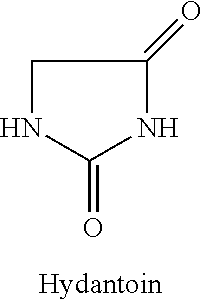Multi-component aqueous gel solution for control of delayed gelation timing and for resulting gel properties
a technology of delayed gelation and aqueous gel solution, which is applied in the direction of chemistry apparatus and processes, sealing/packing, and well accessories, etc., can solve the problems of preventing the use of undesirable fluids, permanent loss of desired fluids, and development of high permeability flow zones
- Summary
- Abstract
- Description
- Claims
- Application Information
AI Technical Summary
Benefits of technology
Problems solved by technology
Method used
Image
Examples
example 1
[0055]Introduction of 0.50 g of a water insoluble crosslinked polyacrylate SAP, AN915 from Expo Chemical Companies in Houston, Tex. directly to the inventive formulation containing 2.00 g sodium silicate, 10.00 g of a 5,000 ppm solution of Kemira's Superfloc® Anionic (SFA) 120 polyacrylamide (PAM) and 10.00 g of Bartlesville Tap Water (BTW). The mixture was shaken and 1.00 g of propylene carbonate was added and the mixture was shaken again. The procedure was a failure because the mixture never dispersed evenly in solution. The super absorbent polymer actually absorbed all of the water prior to the inventive gelling process as described herein.
example 2
[0056]The experiment was repeated using a carrier solvent to disperse the super absorbent polymer into the inventive mixture as for the purposes of stabilizing any post gelling water of syneresis. A gel solution was prepared in the following order of component addition with shaking between the additions: 3.50 g ethylene glycol is added to 0.50 g of SNF's AN 915 SAP; 4.00 g of sodium silicate; 15.00 g of a 5,000 ppm solution of SFA 300 High Molecular Weight (HMW) and SFA 300 Low Molecular Weight (LMW) non-ionic PAM; 20.00 g of BTW; and 1.00 g propylene carbonate was prepared. At this point a homogeneous solution formed that gelled in 35 minutes to a very hard ringing gel. The gel ringing phenomenon was observed by simply putting a slight pressure on the surface of the gel with a finger and the ringing was felt on the sides of the jar. No syneresis was observed up on setting. A portion of the gel was removed and placed in a dish with an equal weight of water. The water was absorbed by...
example 3
[0057]The experiment was repeated using a carrier solvent to disperse the super absorbent polymer into the inventive mixture as for the purposes of stabilizing any post gelling water of syneresis. A gel solution was prepared in the following order of component addition with shaking between the additions: 2.50 g ethylene glycol is added to 0.050 g of SNF's AN 915 SAP; 4.00 g of sodium silicate; 15.00 g of a 5,000 pp solution of Kemira's SF 300 HMW and SF 300 LMW non-ionic PAM; 13.00 g of BTW; and 0.23 g propylene carbonate was prepared. At this point a homogeneous solution formed that gelled in approximately 24 hrs to a soft or weak gel without syneresis useful for permeability modification treatments. A previous sample of the same formulation made without the stabilizing amount of SAP was considered a weak gel with some water syneresis.
[0058]Representative cellulose ethers which can be used in the practice of the present disclosure include, among others, the various carboxyalkyl cel...
PUM
| Property | Measurement | Unit |
|---|---|---|
| temperature | aaaaa | aaaaa |
| weight percent | aaaaa | aaaaa |
| weight percent | aaaaa | aaaaa |
Abstract
Description
Claims
Application Information
 Login to View More
Login to View More - R&D
- Intellectual Property
- Life Sciences
- Materials
- Tech Scout
- Unparalleled Data Quality
- Higher Quality Content
- 60% Fewer Hallucinations
Browse by: Latest US Patents, China's latest patents, Technical Efficacy Thesaurus, Application Domain, Technology Topic, Popular Technical Reports.
© 2025 PatSnap. All rights reserved.Legal|Privacy policy|Modern Slavery Act Transparency Statement|Sitemap|About US| Contact US: help@patsnap.com

